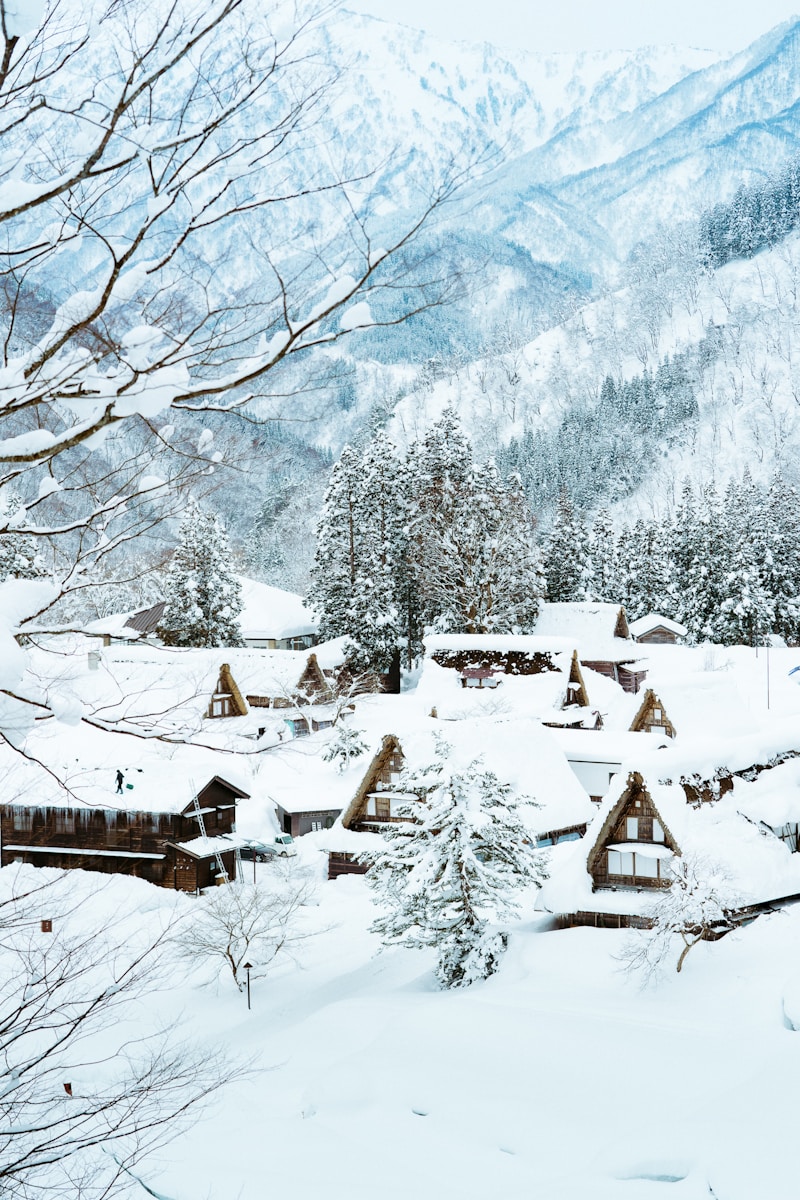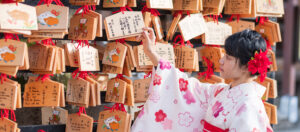Japan, a land of exquisite beauty and profound traditions, offers a unique experience with each changing season. From the snow-capped peaks of Hokkaido to the tropical beaches of Okinawa, the country unveils its diverse landscapes and cultural festivities throughout the year. This year-round journey through Japan’s four distinct seasons—winter, spring, summer, and autumn—reveals not just the natural splendor of the country but also its rich cultural tapestry, celebrated with festivals, culinary delights, and age-old customs. Let’s embark on a captivating exploration of Japan’s seasonal wonders, where each season paints the country with its own palette of colors, flavors, and emotions.
Winter Wonderland: Hokkaido’s Snowy Spectacle
Hokkaido, Japan’s northernmost island, transforms into a winter wonderland, offering breathtaking landscapes blanketed in pristine snow. The frigid temperatures and heavy snowfall create perfect conditions for winter sports, making it a paradise for skiers and snowboarders. The powdery snow, known as "Japow" among enthusiasts, attracts visitors from across the globe. Beyond the slopes, Hokkaido’s frozen lakes and rivers become the stage for ice fishing, snowmobiling, and even ice sculpture competitions. The stark white landscapes, punctuated by occasional wildlife sightings, offer a serene and invigorating escape from the hustle and bustle of city life. In the evenings, traditional ryokans (Japanese inns) welcome guests with warm hospitality, serving locally sourced seafood and vegetables in kaiseki-style feasts, followed by soothing soaks in onsen (hot springs) amidst snowy vistas.
Illuminating Winter: The Sapporo Snow Festival
The Sapporo Snow Festival, held annually in February, is a dazzling highlight of winter in Japan. This week-long event transforms Sapporo, the capital of Hokkaido, into a magical winter landscape filled with enormous ice and snow sculptures. International teams compete to create intricate artworks that range from historical figures to famous landmarks and fantasy scenes. Illuminations at night breathe life into these icy figures, attracting millions of visitors. The festival also features snowboarding competitions, live music, and local Hokkaido delicacies, offering a holistic experience of winter joy and creativity. It’s a testament to the community spirit and the embrace of the cold season, turning the city into a vibrant hub of cultural exchange and artistic expression.
Spring Blooms: The Cherry Blossom Phenomenon
Spring in Japan is synonymous with the fleeting beauty of cherry blossoms, known as "sakura." The entire country eagerly anticipates the sakura zensen (cherry blossom front) as it sweeps from the south in Okinawa to the northern regions of Hokkaido from late March to early May. This natural spectacle brings with it a wave of pink and white blossoms, transforming parks, riversides, and streets into ethereal landscapes. The cherry blossom season is not just a feast for the eyes but a deep cultural symbol of the transient nature of life, inspiring poetry, music, and art for centuries. Families, friends, and coworkers gather under the blooming trees for hanami (flower viewing) parties, a tradition that celebrates both the beauty of nature and the bonds between people. The joyous atmosphere is complemented by seasonal foods like sakura mochi and themed products ranging from cosmetics to beverages, all celebrating the iconic sakura.
Navigating Hanami: Best Spots for Cherry Blossoms
Finding the perfect spot for hanami can be the key to fully experiencing the magic of the cherry blossom season. Tokyo’s Ueno Park, with over a thousand cherry trees, transforms into one of the liveliest places for hanami, complete with food stalls and festive lights. Kyoto’s Maruyama Park and the Philosopher’s Path offer a more tranquil setting, where the historical ambiance enhances the beauty of the blossoms. For those seeking a unique experience, Hirosaki Castle Park in Aomori presents a stunning backdrop with its ancient structures surrounded by over 2,500 trees. The nighttime illumination of cherry blossoms, known as yozakura, provides a different perspective and a romantic atmosphere. While these spots are among the most famous, countless other locations across Japan offer breathtaking views, each with its own charm and character.
Summer Escapes: Okinawa’s Tropical Paradise
As the cherry blossoms fade, the focus shifts to Japan’s southern islands, where summer arrives with a tropical embrace. Okinawa, with its crystal-clear waters, white sandy beaches, and vibrant coral reefs, offers a stark contrast to the country’s mountainous regions. The island’s unique Ryukyu culture, with its own language, music, and dance, adds to the allure of this summer escape. Water activities such as snorkeling, diving, and sea kayaking allow visitors to explore the rich marine life. The islands also host traditional Eisa festivals, featuring dynamic drum performances and parades, which celebrate the ancestors and the Okinawan spirit. At night, beachside barbecues and the gentle sound of the sanshin (a traditional Okinawan instrument) create a relaxing atmosphere, perfect for unwinding after a day of sun and sea.
Fireworks and Festivals: Japan’s Summer Traditions
The Japanese summer is marked by vibrant festivals and spectacular fireworks displays, known as hanabi. These events, held across the country, are a celebration of the season’s energy and vitality. The Sumida River Fireworks Festival in Tokyo and the Aomori Nebuta Festival are among the largest and most famous, drawing crowds from all over. The fireworks, with their elaborate designs and colors, illuminate the night sky, creating a moment of shared wonder. Festivals often feature yukata (summer kimono), traditional dance, and street food, offering a glimpse into Japan’s rich cultural heritage. These summer traditions provide a communal space for enjoyment and reflection, amidst the hustle of modern life, reinforcing the importance of seasonal changes in Japanese culture.
Autumn Gold: Kyoto’s Kaleidoscope of Leaves
As summer fades, the landscape undergoes a dramatic transformation, with Kyoto at the heart of autumn’s display. The city’s numerous temples, shrines, and gardens become canvases for koyo (autumn leaves), with maples turning brilliant shades of red, orange, and yellow. This natural spectacle draws visitors seeking the serene beauty of places like Arashiyama’s bamboo forest and the Tofuku-ji Temple’s famed maple valley. The cooler temperatures and the visual feast of colors make autumn an ideal time for hiking and temple visits, offering a moment of reflection amidst nature’s splendor. The season is celebrated with special temple illuminations and tea ceremonies, providing a deeper connection to Kyoto’s cultural and spiritual heritage.
Harvest Time: Celebrating Autumn’s Bounty
Autumn is also a time of harvest, when Japan celebrates the bounty of the land with various food festivals and Thanksgiving ceremonies. The season brings an abundance of fruits and vegetables, including persimmons, sweet potatoes, and mushrooms. In rural areas, communities come together for rice harvesting, a crucial part of Japan’s agricultural calendar. This period is marked by gratitude for the year’s harvest and the sharing of seasonal dishes at local festivals. Specialties like roasted chestnuts and new rice sake highlight the flavors of autumn, while traditional performing arts and crafts add to the festive atmosphere, making it a time to savor the richness of Japan’s culinary and cultural traditions.
Experiencing Koyo: Autumn Leaf Viewing Tips
To fully appreciate autumn’s vibrant display, timing and location are key. The koyo front moves southward from Hokkaido in late September to the southern regions by late November. National parks, such as Nikko and Hakone, offer expansive views and a variety of trails, catering to both casual viewers and avid hikers. For those looking to avoid crowds, early morning visits or exploring less popular spots can provide a more intimate experience. Many sites offer night illuminations, adding a magical aspect to the already stunning scenery. Preparing for variable weather and checking local forecasts can enhance the experience, ensuring that the beauty of koyo can be enjoyed to its fullest.
Onsen Magic: Hot Springs in the Chilly Seasons
The chilly seasons of autumn and winter in Japan are the perfect times to experience the warmth of onsen. These natural hot springs, found throughout the country, are not only a haven for relaxation but also provide health benefits, thanks to their mineral-rich waters. From outdoor baths with mountain views to historic ryokans with private soaking tubs, the onsen experience can vary widely. The snowy landscapes of Hokkaido and the alpine scenery of Nagano offer some of the most memorable onsen experiences, combining the soothing waters with breathtaking natural beauty. Following onsen etiquette, such as washing before entering the baths and keeping voices low, ensures a respectful and enjoyable experience for all.
Culinary Journey: Seasonal Delights of Japan
Japanese cuisine, known for its emphasis on seasonal ingredients, offers a culinary journey through the country’s four seasons. Winter comfort foods, such as hot pot dishes like nabe and oden, provide warmth and nourishment. Spring celebrates new beginnings with fresh vegetables and the iconic sakura-flavored treats. Summer’s heat is combated with chilled noodles and refreshing sweets like kakigori (shaved ice). Autumn’s harvest is showcased in dishes featuring mushrooms, chestnuts, and sweet potatoes. Throughout the year, seasonal seafood, sourced from Japan’s extensive coastlines, plays a vital role in the culinary landscape. This respect for the seasons not only highlights the freshness of the ingredients but also connects diners with the natural cycle of life.
The enduring beauty of Japan’s seasonal landscapes and traditions offers a profound journey through time and nature. Each season, with its own distinctive charm and cultural festivities, invites visitors to immerse themselves in the country’s rich heritage and natural wonders. From the snowy fields of Hokkaido to the tropical shores of Okinawa, Japan presents a tapestry of experiences that change with the seasons. This year-round journey not only showcases the natural beauty of Japan but also highlights the deep cultural reverence for the changing seasons, making it a unique and unforgettable destination. Whether through the vibrant blooms of spring, the sun-soaked festivities of summer, the golden hues of autumn, or the serene snowscapes of winter, Japan’s seasonal contrasts unveil a world of beauty and tradition waiting to be explored.





